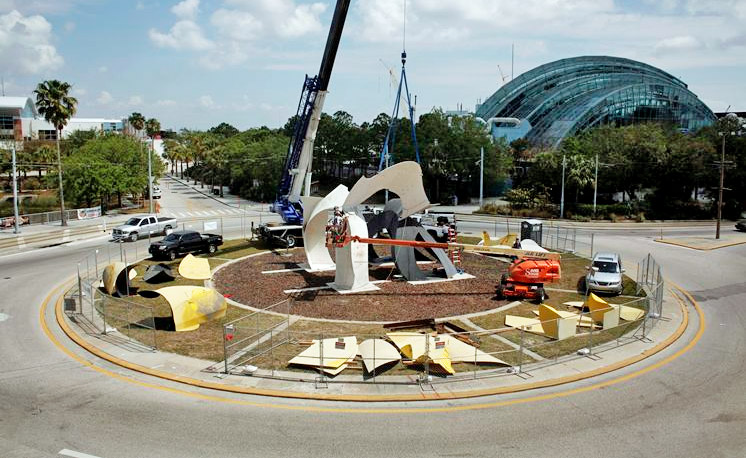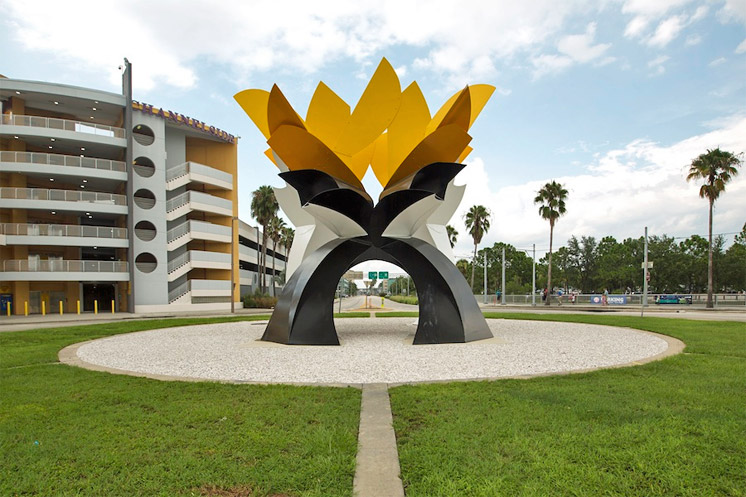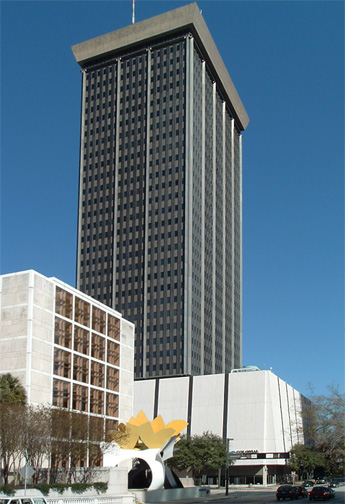|
Downtown Tampa - page 4 |
|||||
|
Built in 1988, the building and sculpture drew rave reviews and stark criticism. Like it or not, it plays a major role in giving downtown Tampa a beautifully distinctive skyline. The 36 foot tall, 19-ton steel and aluminum sculpture, was nicknamed "the Exploding Chicken" by Tampa Tribune columnist Steve Otto. It actually has a name... "Untitled".
"Untitled", 1988, by George Sugarman
George Sugarman (1912–1999) was an
American artist working in the mediums of drawing, painting, and
sculpture. Often described as controversial and forward-thinking,
Sugarman's prolific body of work defies a definitive style. He pioneered
the concepts of pedestal-free sculpture and is best known for his
large-scale, vividly painted metal sculptures. His innovative approach to
art-making lent his work a fresh, experimental approach and caused him to
continually expand his creative focus. During his lifetime, he was
dedicated to the well-being of young emerging artists, particularly those
who embraced innovation and risk-taking in their work. In his will,
Sugarman provided for the establishment of The George Sugarman Foundation,
Inc. |
RIVERGATE TOWER
Often referred to as "The Beer Can" by Tampans, the building was commissioned in the 1980s by North Carolina National Bank and its CEO, Hugh McColl, who wanted a new national headquarters. It was built at a cost of $150 million in 1988 for NCNB, predecessor to Nations Bank, which later merged with Bank of America.
Rivergate Tower was designed by famed architect Harry Wolf, who envisioned the corner of Kennedy Boulevard and Ashley Drive as the gateway to downtown. The distinctive cylindrical shape was meant to symbolize a lighthouse, complete with spotlights on the roof, and represent optimism.
Gateway to Downtown, the Kennedy Blvd. Bridge The Rivergate Tower and the Bank of America tower, formerly the Barnett Bank, as seen from the west end of the Kennedy Blvd. bridge.
Wolf used the elegant Fibonacci number series to design numerous aspects of the tower. Each number in the series is the sum of the previous two-- 0, 1, 1, 2, 3, 5, 8, 13, etc. These proportions were used to draw up the tower’s radius, floor heights, dimensions, and frequency of windows. The series is often found in nature, such as in tree branching or the patterns in a pine cone. “Everything flows together,” said Wolf. Other intricacies include concentric circles in the building’s lobby that mark distance of time and space and 365 paving stones around the floor of the tower to represent the calendar. The design has been described as “brilliant mathematic artistry.”
The tower has received architectural awards around the world, including the 1993 National Honor Award from the American Institute of Architects. The connected Cube building was designed to mimic Tampa’s urban grid.
From "Fans of Kiley Garden push for its restoration" by Paul Guzzo, Tampa Tribune.
At 31 floors (454 ft.), Rivergate Tower is the 6th tallest skyscraper in Tampa. The building is faced in French and Texas limestone, making it one of the tallest limestone structures in the world.
The adjacent building, "the cube", was used in the movie "The Punisher" as Howard Saint's (played by John Travolta) office and nightclub.
Together, the tower and the cube provide 515,965 square feet of rentable space. Parking is provided in a 2-story sublevel structure with a total of 731 safe and secure parking spaces.
The building is a favorite shot from across the river, and often used by Monday Night Football as the "backscreen" to superimpose player images during commercial breaks with the building reflected in the Hillsborough River.
See interior and exterior photos at the Wolf Architecture website, http://www.wolfarc.com/nations-bank/ |
||||
|
Sugarman disliked labels, believing they
oversimplified the complexity of art. Though his body of work resists
classification and oversimplification, he was influenced by Surrealism,
Cubism, Baroque sculpture and Abstract Expressionism.
An intellectually vigorous man, he pressed for innovation throughout his career. Sugarman’s sculptures stood out particularly in light of the minimalism of the sixties. Many of Sugarman’s sculptures are multi-colored, geometric and biomorphic at the same time. Energizing space with color, Sugarman was known for his expansive “polychrome profusions,” which reflected “the existential disorder of life.” Born in 1912 in the Bronx, his father was a dealer in Oriental rugs, his mother a dedicated amateur singer. He spent much of his childhood traveling with his father on sales trips through the Eastern and Southern United States and said that the colors and patterning of Persian and Turkish rugs made an indelible impression on him. Mr. Sugarman graduated from City College in 1934. From 1941 to 1945 he served in the Navy, assigned to a hospital in the Pacific theater. His real art education began after the war, when he went to Paris on the G.I. Bill, studying with the Cubist sculptor Ossip Zadkine in 1951-52. For the next three years he worked in Paris and traveled throughout Europe. He was especially affected by Baroque architecture. |
|||||
|
Over the next 30 years, his output was prodigious and it included thousands of paintings and vividly colored relief collages. In the seventies, Sugarman created numerous large sculptures, commissioned for public spaces in the United States, Europe, Asia and Australia. He was among the first to promote placing sculpture on the ground without the interference and formality of pedestals. He believed that “public art” should be outdoors, in a natural environment, not indoors, physically isolated. After 1970 Mr. Sugarman turned increasingly to large outdoor sculpture commissions, starting with one for the Xerox Corporation in El Segundo, Calif. Over the next 20 years he executed more than 30 commissions in the United States and abroad. He became interested in making his work user-friendly, incorporating benches and canopies into the architecturally scaled works. In 1975 one such piece, commissioned by the General Services Administration for a Federal building in Baltimore, was opposed by several judges with offices in the building. They first opposed the piece on esthetic grounds but later said that it could be dangerous for children or could be used as a soapbox from which protesters might make speeches. Sugarman taught at Hunter College for ten years. He was a visiting associate professor at the Yale University Graduate School of Art. He lectured at many universities including Purdue in West Lafayette in 1975. Between 1977 and 1986 he had five exhibitions at the Robert Miller Gallery. His works are among the public collections of the Whitney Museum of American Art, the Museum of Modern Art, the Metropolitan Museum of Art in New York City; the Art Institute in Chicago, the Walker Museum in Minneapolis and the Fogg Museum, Harvard University, Cambridge. Thirty major commissions reside in the United States, Asia and Australia. Sugarman’s work has been the subject of more than 90 solo or group exhibitions. The above information about George Sugarman comes from:
|
|||||
|
|
Functional Art vs. Stand Alone Art and "Plop Art" While a sculpture in an office plaza can serve as a landmark, or a painting prominently placed in a reception area can offer a welcoming respite to a visitor, public art in Tampa is much more. In several projects, the Public Art program is taking an integrated approach whereby the public art component is incorporated into the design of the facility. This allows for unique partnerships that enhance the facilities with integral, and personal design elements.
City of Tampa Division of Art Programs
View more of Tampa's public art
|
||||
|
In 2005, America's Capital Partners of Miami bought the office tower, including the art, for $35.5 million. Six months later, the company said it wanted the sculpture gone and offered to donate it to the city. In early 2009, the city announced its new roost: a traffic circle in the Channel District. Plans to move the sculpture hit a snag in July 2010 when city officials learned it would cost twice as much to move and refurbish as expected. America's Capital Partners agreed to kick in $35,000 to help with the move, and local businesses offered to clean and reinstall it for free. The total bill to the city was supposed to be $15,000. The sculpture was dismantled in the spring, but then complications emerged. The site was chosen has a lot of utilities underground, so a traditional concrete mat foundation could not be used. The sculpture also needed extra securing because of "uplift," which could send the piece airborne in a hurricane. "It's the only metal chicken in the world that could fly" said Bob McDonaugh, the city's manager for economic development in the Channel District. Plans called for four separate pads secured by pilings. McDonaugh got a good price on the pilings by piggybacking on construction of a nearby parking garage. But by the time the city had acquired all the permits from the Florida Department of Transportation, the drilling rig was gone. The cost to build the pads doubled. "Times are tight. Money's tight. I had vowed to do this with as much volunteer work as possible," he said, pledging the sculpture will eventually go up. "It's a local icon. I wanted to save it," McDonaugh said. "We'll get it done."
The above story and photo at right is from: Problems with "Exploding Chicken" sculpture come home to roost, July 7, 2010, Tampa Bay Times.
The "Exploding Chicken" has been disassembled and moved And so the sculpture remained in storage for 3 years until it was reassembled on Channelside Drive just north of the Florida Aquarium in April 2013. |
|||||
|
|
|||||
|
|
The Lykes Building, (Park Tower) formerly the First Florida Tower and the First National Bank building, 111 E. Madison.
|
||||
|
On the banks of the Hillsborough River, left to right: Radisson Riverwalk Hotel, AmSouth Building and Wachovia Center, formerly the First Union Building.
This view can be seen from the Kennedy Blvd bridge over the Hillsborough River, looking south. |
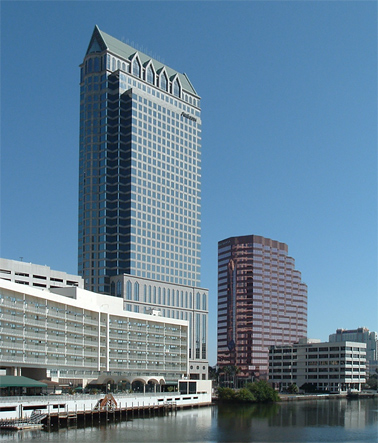 |
||||
|
Downtown 1 | Downtown 2 | Downtown 3 | Downtown 4 | Downtown 5 | Downtown 6 | Tampapix Home |
|||||
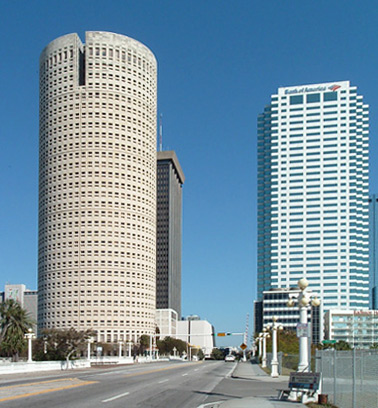
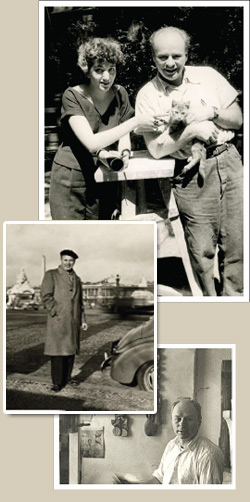 Returning to New York in 1955 Mr.
Sugarman took a loft on East 23rd Street where he began working in
laminated wood and taught carpentry at a private school to support
himself. Beginning in 1956 he exhibited in group
shows at the Hansa and Brata Galleries. After making carved wood
sculptures that resembled those of Raoul Hague, he made his first
polychrome sculpture in 1959 and had his first solo gallery show at the Widdifield Gallery in 1960.
In 1961, Sugarman received international recognition when he won second
prize for sculptural creativity in the Carnegie International Exhibition
of Contemporary Painting and Sculpture. He was represented in the late
60's by the Fischbach Gallery.
Returning to New York in 1955 Mr.
Sugarman took a loft on East 23rd Street where he began working in
laminated wood and taught carpentry at a private school to support
himself. Beginning in 1956 he exhibited in group
shows at the Hansa and Brata Galleries. After making carved wood
sculptures that resembled those of Raoul Hague, he made his first
polychrome sculpture in 1959 and had his first solo gallery show at the Widdifield Gallery in 1960.
In 1961, Sugarman received international recognition when he won second
prize for sculptural creativity in the Carnegie International Exhibition
of Contemporary Painting and Sculpture. He was represented in the late
60's by the Fischbach Gallery.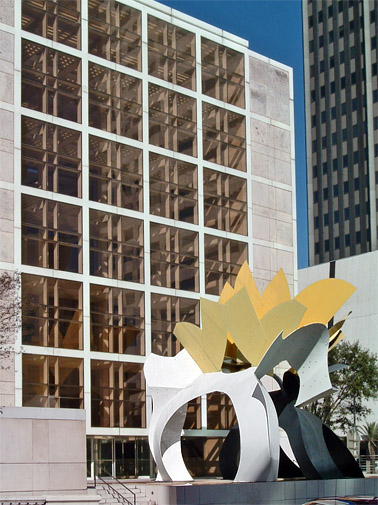
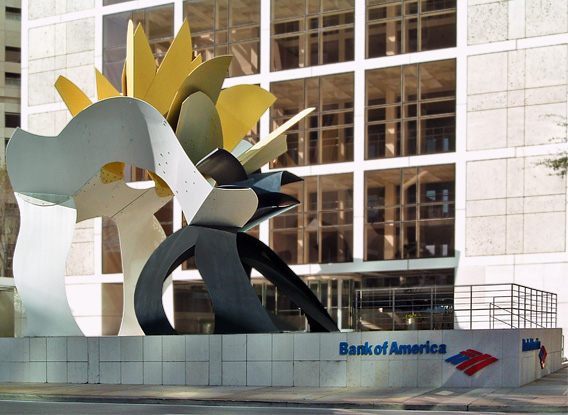
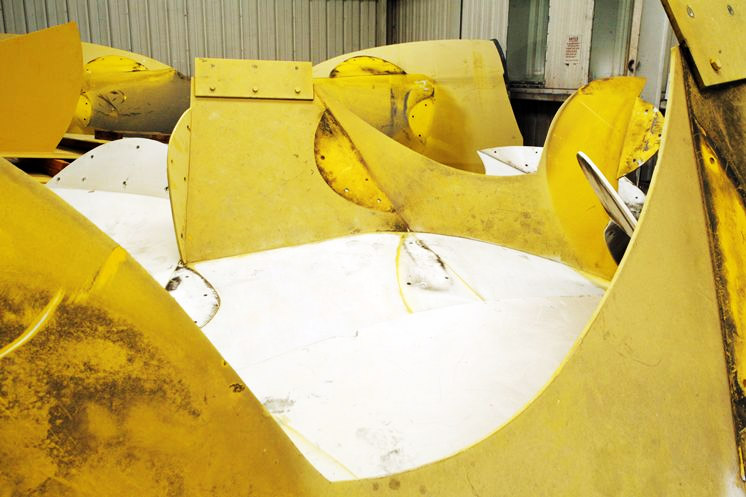 As
McDonaugh searched for solutions, America's Capital Partners still waited
for official acceptance of its donation. "The city agreed to provide ACP
with donation papers for the sculpture," attorney Jason Baruch wrote in a
letter. As added pressure, the chicken letter was accompanied by another
missive with a gentle reminder that the city has violated the terms of a
lease agreement by, among other things, not properly fixing a parking
garage adjacent to Rivergate Tower, destroying a directional sign to the
garage, and failing to replace parking spaces lost during construction of
the Tampa Museum of Art and Curtis Hixon Waterfront Park.
As
McDonaugh searched for solutions, America's Capital Partners still waited
for official acceptance of its donation. "The city agreed to provide ACP
with donation papers for the sculpture," attorney Jason Baruch wrote in a
letter. As added pressure, the chicken letter was accompanied by another
missive with a gentle reminder that the city has violated the terms of a
lease agreement by, among other things, not properly fixing a parking
garage adjacent to Rivergate Tower, destroying a directional sign to the
garage, and failing to replace parking spaces lost during construction of
the Tampa Museum of Art and Curtis Hixon Waterfront Park.
